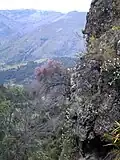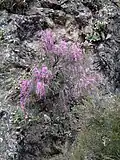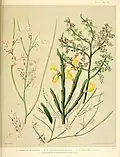Carmichaelia carmichaeliae
| Carmichaelia carmichaeliae | |
|---|---|
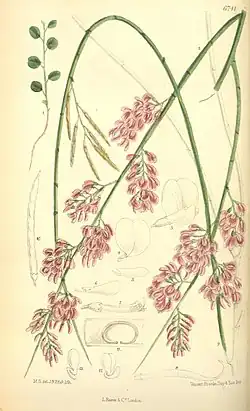
| |
| Scientific classification | |
| Kingdom: | Plantae |
| Clade: | Tracheophytes |
| Clade: | Angiosperms |
| Clade: | Eudicots |
| Clade: | Rosids |
| Order: | Fabales |
| Family: | Fabaceae |
| Subfamily: | Faboideae |
| Genus: | Carmichaelia |
| Species: | C. carmichaeliae
|
| Binomial name | |
| Carmichaelia carmichaeliae | |
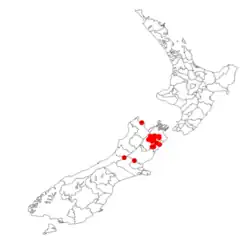
| |
| Occurrence data from AVH | |
| Synonyms | |
|
Notospartium carmichaeliae Hook.f. | |
Carmichaelia carmichaeliae, also known as Marlborough pink broom or just pink broom, is a species of plant in the family Fabaceae. It is endemic to New Zealand, found only in the South Island.[3][4] It is classified as having the "Nationally Critical" conservation status under the New Zealand Threat Classification System.[1]
Description
A shrub that grows up to 4 m tall, C. carmichaeliae has drooping green-yellow twigs with no leaves. Its small pink flowers have dark streaks clustered into sprays.[5]
Taxonomy
The species was originally described with the name Notospartium carmichaeliae by Joseph Dalton Hooker in 1899.[6] It was revised as C. carmichaeliae by Peter Brian Heenan in 1998.[3]
Distribution and habitat
C. carmichaeliae is endemic to the Marlborough region of New Zealand's South Island, north of the Awatere Fault. It is usually found in steep valleys and gorges or on cliff faces at up to around 800 m elevation.[5]
Ecology and threats
C. carmichaeliae flowers between November and January, and fruits all year long. The seeds are dispersed by wind and seed predation.
The species is highly threatened, considered "Nationally Critical" under the New Zealand Threat Classification System. Threats include browsing by introduced animals, competition from weeds, and aerial spraying of invasive plants such as gorse.[5]
Gallery
References
- ^ a b Lange, Peter J. de; Rolfe, Jeremy R.; Barkla, John W.; Courtney, Shannel P.; Champion, Paul D.; Perrie, Leon R.; Beadel, Sarah M.; Ford, Kerry A.; Breitwieser, Ilse; Schönberger, Ines; Hindmarsh-Walls, Rowan (1 May 2018). "Conservation status of New Zealand indigenous vascular plants, 2017" (PDF). New Zealand Threat Classification Series. 22: 1–86. OCLC 1041649797.
- ^ Heenan PB. (1998). "An emended circumscription of Carmichaelia, with new combinations, a key, and notes on hybrids". New Zealand Journal of Botany. 36 (1): 53–63. doi:10.1080/0028825X.1998.9512546. ISSN 0028-825X.
- ^ a b de Lange, P.J. (1998). "Notospartium carmichaeliae". IUCN Red List of Threatened Species. 1998: e.T30489A9547135. doi:10.2305/IUCN.UK.1998.RLTS.T30489A9547135.en. Retrieved 16 November 2021.
- ^ "Carmichaelia carmichaeliae (Hook.f.) Heenan". Biota of New Zealand. Archived from the original on 21 May 2024. Retrieved 9 August 2025.
- ^ a b c "Carmichaelia carmichaeliae". New Zealand Plant Conservation Network. Archived from the original on 12 July 2025. Retrieved 9 August 2025.
- ^ Kirk, Thomas (1899), The Students' Flora of New Zealand, doi:10.5962/BHL.TITLE.54373, OCLC 5905328, Wikidata Q47062405
![]() Media related to Carmichaelia carmichaeliae at Wikimedia Commons
Media related to Carmichaelia carmichaeliae at Wikimedia Commons

